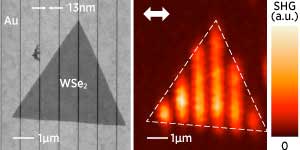| Posted: Jun 08, 2018 |
Photonics - Getting into the groove
(Nanowerk News) By combining two very different light-interacting nanostructures, A*STAR researchers have demonstrated a surprisingly strong enhancement of a frequency doubling effect (ACS Nano, "Selectively plasmon-enhanced second-harmonic generation from monolayer tungsten diselenide on flexible substrates").
|
|
The functional manipulation and transformation of light in optical circuits is an exciting area of research that combines the physics of light and matter in unusual ways. At the cutting edge of this technology, researchers are exploring new structural combinations of materials that could give rise to potentially useful functions, particularly in nanoscale systems.
|
 |
| (Left) Scanning electron micrograph of a WeS2 flake on a nano-groove gold film. (Right) Second harmonic generation (SHG) in monolayer WSe2 on a nano-groove gold film. (© ACS)
|
|
Joel Kwang Wei Yang, Zhaogang Dong and their colleagues at A*STAR’s Institute of Materials Research and Engineering have been working on highly precise techniques for patterning thin gold films with nanoscale groove structure to enhance light interaction and produce light resonance effects known as plasmonics.
|
|
“We’ve seen from our previous studies that 10 nanometer-wide grooves in a gold film can support plasmon modes by concentrating light along the grooves,” explains Yang. “We then figured that draping a two-dimensional material on to this special substrate might make for an interesting system due to confinement of light into quasi one-dimensional strips.”
|
|
In collaboration with researchers from the National University of Singapore, Imperial College London and the King Abdullah University of Science and Technology in Saudi Arabia, Yang and Dong fabricated, analyzed and modelled a system consisting of the nano-grooved gold film topped with an atomically thin flake of tungsten selenide (WSe2). The result was a remarkable 7,000-fold multiplication of an effect called second harmonic generation (SHG), by which two photons combine to produce a single photon with double the energy (or frequency).
|
|
“This work was really a marvel of nanofabrication and delicate sample handling,” says Yang. “We had excellent collaborators who provided beautiful WSe2 flakes, and a talented PhD student who has since graduated, Wang Zhuo, worked on state-of-the-art transfer techniques to get these flakes on to our nanotrenches in the right orientation.”
|
|
Notably, the sample survived both the transfer onto a separate transparent substrate and many bending cycles without degradation in SHG emission, making it a potentially resilient and versatile platform for further development.
|
|
“Gold films are flexible and retain their form well, and the nanoscale grooves produce strong optical enhancements, while monolayer WSe2 is an efficient SHG material but interacts only weakly with light due to its atomic thickness,” says Dong. “We were able to combine the advantages of both materials to achieve a flexible, ultra-compact, and efficient device for SHG, with potential applications for optical frequency doubling in nanoscale devices.”
|

